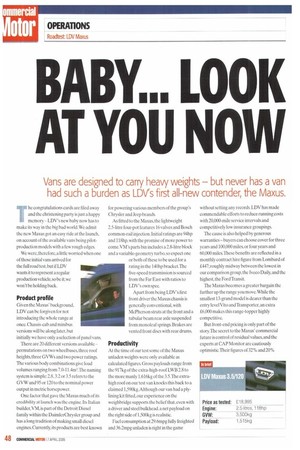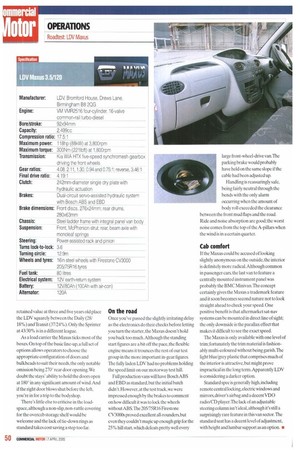BABY... LOOK AT YOU NOW
Page 48

Page 50

If you've noticed an error in this article please click here to report it so we can fix it.
Vans are designed to carry heavy weights — but never has a van had such a burden as LDV's first all-new contender, the Maxus.
he congratulations cards are filed away and the christening party is just a happy memory — LDV's new baby now has to make its way in the big bad world.We admit the new Maxus got an easy ride at the launch, on account of the available vans being pilotproduction models with a few rough edges.
We were, therefore, a little worried when one of those initial vans arrived for the full road test, but if LDV wants it to represent a regular production vehicle, so be it; we won't be holding back.
Product profile
Given the Maxus' background, LDV can be forgiven for not introducing the whole range at once. Chassis-cab and minibus versions will be along later, but initially we have only a selection of panel vans.
There are 20 different versions available — permutations on two wheelbases, three roof heights, three GVWs and two power ratings. The various body combinations give load volumes ranging from 7.0-11.4m3.The naming system is simple: 2.8, 3.2 or 3.5 refers to the GVW and 95 or 120 to the nominal power output in metric horsepower.
One factor that gave the Maxus much of its credibility at launch was the engine. Its Italian builder,VM, is part of the Detroit Diesel family within the DaimlerChrysler group and has a long tradition of making small diesel engines. Currently, its products are best known for powering various members of the group's Chrysler and Jeep brands.
As fitted to the Maxus, the lightweight 2.5-litre four-pot features 16 valves and Bosch common-rail injection. Initial ratings are 94hp and 118hp, with the promise of more power to come. VM's parts bin includes a 2.8-litre block and a variable-geometry turbo, so expect one or both of these to be used bra rating in the 140hp bracket.The five-speed transmission is sourced from the Far East with ratios to LDV's own spec.
Apart from being LDV's first front driver the Maxus chassis is generally conventional, with McPherson struts at the front and a tubular beam rear axle suspended from monoleaf springs. B rakes are vented front discs with rear drums.
Productivity At We time of our test some of the Maxus unladen weights were only available as calculated figures. Gross payloads range from the 917kg of the extra-high-roof LWB 2.8 to the more manly 1,616kg of the 3.5.The extrahigh roof on our test van knocks this back to a claimed 1,590kg.Although our van had a plylining kit fitted, our experience on the weighbridge supports the belief that, even with a driver and steel bulkhead, a net payload on the right side of 1,500kg is realistic.
Fuel consumption at 29.6mpg fully freighted and 36.2mpg unladen is right in the game without setting any records. LDV has made commendable efforts to reduce running costs with 20,000-mile service intervals and competitively low insurance groupings.
The cause is also helped by generous warranties — buyers can choose cover for three years and 100,000 miles, or four years and 60,000 miles.These benefits are reflected in a monthly contract hire figure from Lombard of £447; roughly midway between the lowest in our comparison group, the Iveco Daily, and the highest, the Ford Transit.
The Maxus becomes a greater bargain the further up the range you move. While the smallest 13-grand model is dearer than the entry level Vito and Transporter, an extra £6,000 makes this range-topper highly competitive.
But front-end pricing is only part of the story The secret to the Maxus' commercial future is control of residual values, and the experts at CAP Monitor are cautiously optimistic. Their figures of 32% and 20% retained value at three and five years old place the LDV squarely between the Daily (28/ 18%) and Transit (37/24%). Only the Sprinter at 43/30% is in a different league.
As a load carrier the Maxus ticks most of the boxes. On top of the basic line-up, a full set of options allows operators to choose the appropriate configuration of doors and bulkheads to suit their needs, the only notable omission being 270° rear door opening. We doubt the stays' ability to hold the doors open at 180' in any significant amount of wind. And if the right door blows shut before the left, you're in for a trip to the bodyshop.
There's little else to criticise in the loadspace, although a non-slip, non-rattle covering for the overcab storage shelf would be welcome and the lack of tie-down rings as standard takes cost saving a step too far.
On the road
Once you've passed the slightly irritating delay as the electronics do their checks before letting you turn the starter, the Maxus doesn't hold you back too much. Although the standing start figures are a bit off the pace,the flexible engine means it trounces the rest of our test group in the more important in-gear figures. The fully laden LDV had no problems holding the speed limit on our motorway test hill.
Full production vans will have Bosch ABS and EBD as standard, but the initial batch di dn 't. However,at the test track,we were impressed enough by the brakes to comment on how difficult it was to lock the wheels without ABS. The 205/75R16 Firestone CV3000s proved excellent all-rounders,but even they couldn't magic up enough grip for the 25% hill start, which defeats pretty well every large front-wheel-drive van.The parking brake would probably have held on the same slope if the cable had been adjusted up.
Handling is reassuringly safe, being fairly neutral through the bends with the only alarm occurring when the amount of body roll exceeded the clearance between the front mud flaps and the road. Ride and noise absorption are good: the worst noise comes from the top of the A-pillars when the wind is in a certain quarter.
Cab comfort
if the Maxus could be accused of looking slightly anonymous on the outside, the interior is definitely more radical.Although common in passenger cars, the last van to feature a centrally mounted instrument panel was probably the BMC Minivan.The concept certainly gives the Maxus a trademark feature and it soon becomes second nature not to look straight ahead to check your speed. One positive benefit is that aftermarket sat-nay systems can be mounted in direct line of sight; the only downside is the parallax effect that makes it difficult to see the exact speed.
• The Maxus is only available with one level of trim;fortunately the trim material is fashionably multi-coloured without being garish.The light blue/grey plastic that comprises much of the interior is attractive, but might prove impractical in the long terrn.Apparently LDV is considering a darker option.
Standard spec is generally high, including remote central locking, electric windows and mirrors, driver's airbag and a decent'VDO radio/CD player.The lack of an adjustable steering column isn't ideakalt hough it's still a surprisingly rare feature in this van sector. The standard seat has a decent level of adjustment, with height and lumbar support as an option..
















































































































































































































